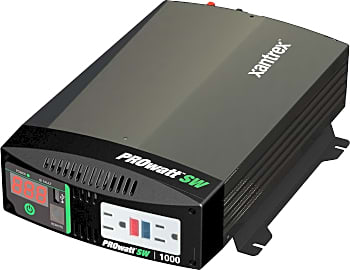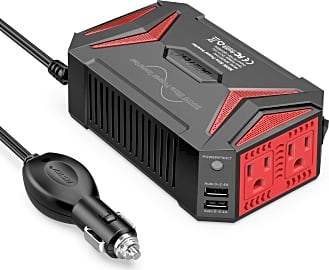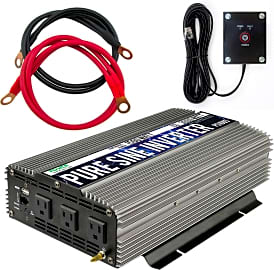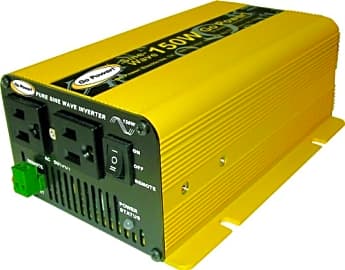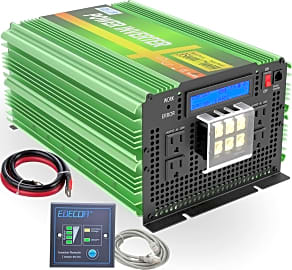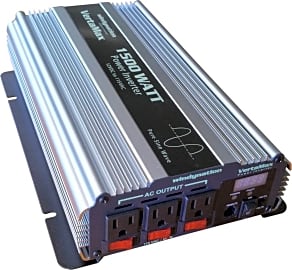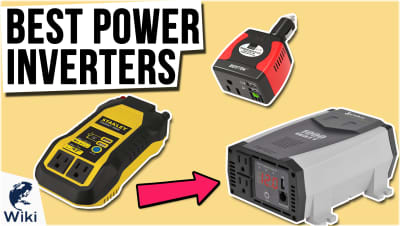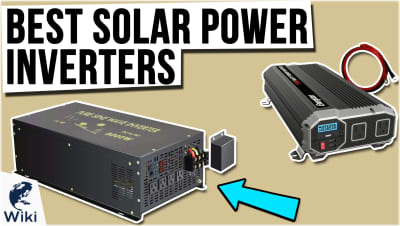The 8 Best Pure Sine Wave Inverters

This wiki has been updated 34 times since it was first published in April of 2018. Not only are pure sine wave inverters useful for travelers in boats and RVs, but they can also supply backup electricity during an outage. They take DC power, which can come from a solar panel or a car battery, and convert it into alternating current, which is used by most appliances and gadgets. For safety, always hire a knowledgeable, licensed electrician for installations that require wiring. When users buy our independently chosen editorial selections, we may earn commissions to help fund the Wiki.
Editor's Notes
November 02, 2020:
While modified sine wave inverters are inexpensive and might get the job done for simple systems that don’t involve any delicate electronics, you’ll want to invest in one of these pure sine models when you’re running things like newer LED TVs, audio equipment, laser printers, and microwaves. Today the Renogy 3000W joins the list, and it’s designed to provide a clean and smooth output for your electronics and appliances, similar to that of shore power. It ensures low harmonic distortion and works with sealed lead acid, gel, flooded, and lithium iron phosphate batteries. It’s designed to alert you to problems like over-voltage, dangerous temperatures, and overloads, and is equipped with a ground fault circuit interrupter. In this update we also replaced the currently unavailable Edecoa 1000 with the more powerful Edecoa 3500W, which is built for the long haul, thanks to two cooling fans, copper terminals, and intelligent power management. It’s also made with convenience in mind, with a wired remote that lets you control it and check your battery’s status from a distance away. Leaving our selection today, due to availability concerns, is the Novopal 1500.
We kept the Samlex America PST-2000 in a prominent spot on the list, which is an energy-efficient choice with a temperature-controlled cooling fan and low interference. It’s suitable for both long-term continuous operation and for serving as an emergency backup. If you wish to support a range of appliances at once, the Xantrex ProWatt is worthy of a look. It's got a built-in digital display, two outlets, and a USB port. It also offers a host of safety features, like surge protection, low-voltage shutdown, overload shutdown, and over-temperature shutdown. For an ultra-compact choice that can plug into your car’s cigarette lighter socket and power up to four devices at once, check out the Bestek 300W, which remains cool to the touch and features a built-in 40-amp fuse. It sports a durable aluminum alloy housing, yet remains lightweight at less than two pounds.
June 25, 2019:
Investing in a pure sine wave inverter makes sense when you’re living or traveling off the grid, as well as for backup power during electrical outages at your home. These are safer than modified sine wave inverters, as they’re better equipped to protect your electronics and appliances. They’re also quieter and less likely to experience errors.
Today, there are plenty of budget-friendly, reliable selections on the market if you’re interested in just powering a few devices at a time. For example, the Bestek 300W, which joins our list today, is sold at an affordable price and features two AC outlets and two USB ports. This worry-free choice provides plenty of safeguards, thanks to its built-in, 40-amp fuse and protection against overheating, under-and over-voltage charging, and short circuiting. At under two pounds and 8x5 inches in size, it’s a highly portable choice that will fit well in your car or any other confined space.
The Go Power! GP-SW150-12 is another new addition to our list, and it’s also intended for smaller loads – of up to 150 watts. (It’s also sold in higher, 300- and 1500-watt capacities for those who need to handle heavier loads.) It operates quietly, without any annoying buzzing or humming, and comes in a bright yellow housing, so you’ll have no problem spotting it in your cabinet or on your workbench whenever it’s needed.
Leaving the list is the Cam2 DC to AC, due to issues with availability. On a safety-related note, if an installation involves tying such a device to your power grid (or if there’s any other wiring involved), be sure to hire a licensed, experienced electrician.
Not All Electricity Is Equal
While all of these objects technically operate thanks to the flow of electrons, they run on two different principles: those of alternating and direct current.
It's difficult to imagine a world without electricity. And just as important as the fanciest new GPUs and smartphones are the more mundane electrical appliances like refrigerators, air conditioners, and electromagnetic motors in items like washing machines and vacuum cleaners. While all of these objects technically operate thanks to the flow of electrons, they run on two different principles: those of alternating and direct current.
Most people are familiar with Thomas Edison, the most renowned US inventor ever. Famous for his refinements to the mainstream light bulb, Edison had a major hand in the fundamental development of modern electrical engineering. His polymath contemporary and colleague Nikola Tesla was similarly responsible for much innovation, though he never received much credit or profit, thanks to a string of misfortunes and poor business decisions.
The two were at odds as to which format the USA and, eventually, the world should adopt for general power transmission. The Edison-backed direct current couldn't reach farther than two miles, and wasn't particularly easy to modulate. Therefore, it required large, independent distribution stations, which were prohibitively costly and inefficient. Tesla was convinced that alternating current was the wave of the future thanks to its viability over long distances and the relative ease of converting it. He scored a victory in the friendly war when he crossed paths with another Edison rival, in famed industrialist George Westinghouse, whose visions of a hydroelectric Niagara Falls were close to fruition; he needed only a bit more genius and inspiration to completely revolutionize power generation.
A Tale Of Two Currents
The difference between the two are in the names. AC fully alternates polarity back and forth at a consistent frequency, and DC remains at a constant magnitude. Ever the philosopher, Tesla felt that all energies were cyclical in some way. This inspired him to send multiple alternating currents down the same circuit, but with their waveforms offset, so they balanced each other out — a method that greatly increased the stability and safe load levels of wire. In the end, Tesla's polyphasic transmission theory led to successful AC generation at Niagara Falls, worldwide adoption of alternating current, and Edison's somewhat tongue-in-cheek admission that his adversary had won the War of the Currents.
Even when stepped down to reasonable levels, the constantly fluctuating nature of AC just didn't cut it for some machines.
In truth, humanity itself was the winner, and Edison didn't lose, either. It turns out that Tesla's 3-phase power, while perfect for high-capacity, long-distance distribution, was qualitatively different from direct current. Efficient transmission across thousands of miles called for dangerously high voltages. Even when stepped down to reasonable levels, the constantly fluctuating nature of AC just didn't cut it for some machines. The transistors making up today's computer chips need a specific polarity — supplying them with AC might just melt them. Another early, yet lasting example is the automobile, which uses an ignition system and battery charger that call for specific, consistent, regulated power levels, lest they literally light on fire and possibly explode.
Here's the tricky part. Even DC generators initially create alternating current, but to harness it, they have to immediately convert it to a direct current. Commutators, a set of physical switches (often called brushes) that operate in succession as a motor spins, first served to point currents in a uniform direction. Found in so-called brushless motors, rectifiers consist of a matrix of diodes that essentially direct alternating electron traffic down a series of one-way streets.
After the rectifier is where things really get interesting. Because once you've combined kinetic and magnetic energy to form AC power and converted it right away to DC, there's a chance you might just have to convert it back.
A Shockingly Regular Voltage
To return the DC to an alternating state, a set of transistors releases it in pulses, at frequency and energy levels that mimic those of pristine AC. The simplest of these work at the relatively low frequency of 120 hertz, which leads to a blocky waveform unlike the smooth sine wave of phasic, grid power. This non-ideal shape can essentially confuse and even damage circuitry that relies on constant, 60-hertz fluctuation. To mitigate this, engineers increased the frequency at which the transistors fire, while researching a way to make choppy, converted AC more like what comes out of the wall.
The simplest of these work at the relatively low frequency of 120 hertz, which leads to a blocky waveform unlike the smooth sine wave of phasic, grid power.
A few different designs serve this purpose today. Some operate much like modulated-wave units, but at higher frequencies, while sometimes employing a series of step-down/step-up transformers to take the rough edges off. These are compact and lightweight, but suffer from reliability and inefficiency issues, especially with low-power signals. Another type, called a mixed-frequency topology, uses a range of individual transformers operating at progressive voltages. When superimposed on each other, their phases line up to simulate a surprisingly realistic wave. Because they contain an excessive amount of parts, they're usually too costly and large-scale for consumer use.
Some recent models use ferroresonant transformers; these novel circuits use the phase shift of two competing magnetic fields to absorb spikes and consistently regulate a signal's voltage. Under load, their capacitance can even serve as a buffer, sustaining nominal voltage for crucial milliseconds, possibly preventing damage to systems or data. Simple, safe, and reliable, ferroresonant transformers are popular among consumer inverters as well as electricians, though they do have some idiosyncrasies such as heat, buzzing, and almost no feedback or dynamic control.
There was a time when a sine-wave inverter was an esoteric and overly expensive consideration for most regular people, but advancements in materials and design are changing that. This is important because today there are more high-tech, powerful electrical devices either on the go or off the grid than ever before. In fact, with the emergence of renewable energy sources, it's more pertinent than ever to claim energy independence. So, rest easy in the knowledge that even if the power goes out, you can still fire up the generator and charge your phone.



